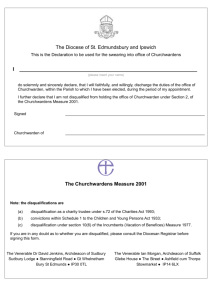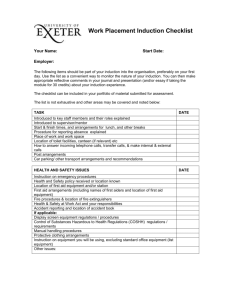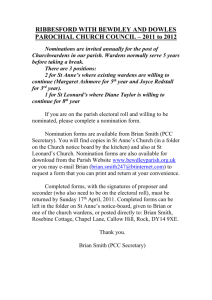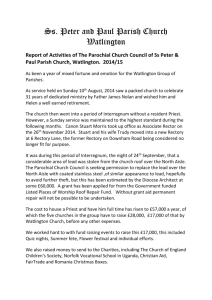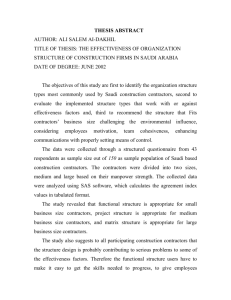Church Health & Safety Policy - St Mark`s Church, Leamington Spa
advertisement
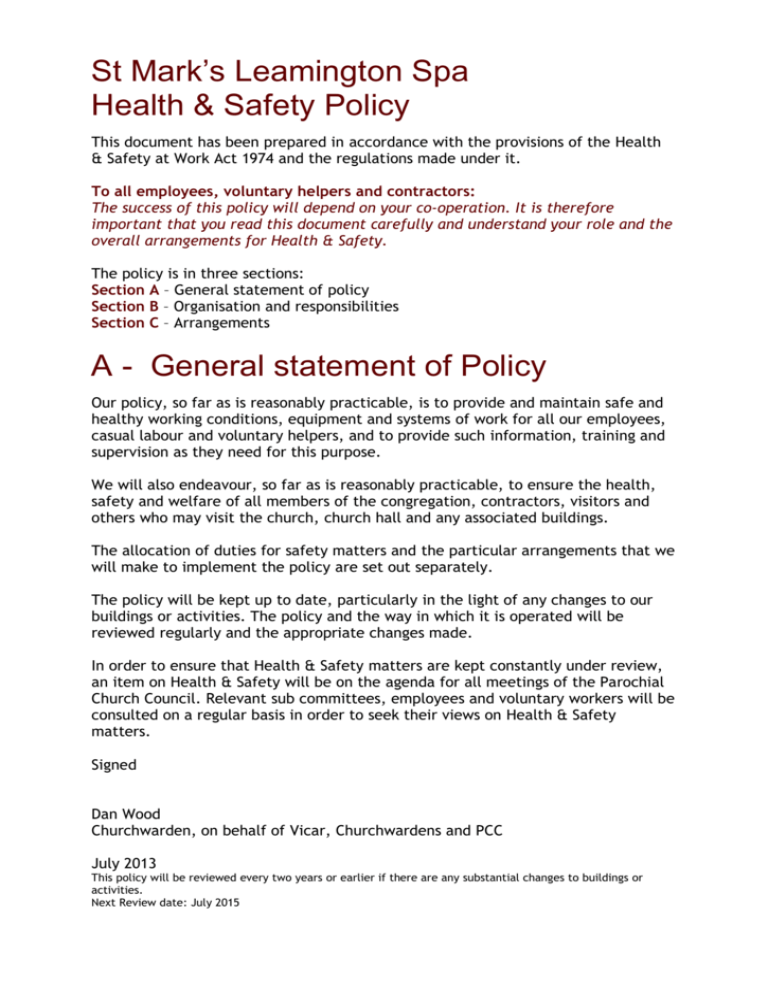
St Mark’s Leamington Spa Health & Safety Policy This document has been prepared in accordance with the provisions of the Health & Safety at Work Act 1974 and the regulations made under it. To all employees, voluntary helpers and contractors: The success of this policy will depend on your co-operation. It is therefore important that you read this document carefully and understand your role and the overall arrangements for Health & Safety. The policy is in three sections: Section A – General statement of policy Section B – Organisation and responsibilities Section C – Arrangements Note A - General statement of Policy Our policy, so far as is reasonably practicable, is to provide and maintain safe and healthy working conditions, equipment and systems of work for all our employees, casual labour and voluntary helpers, and to provide such information, training and supervision as they need for this purpose. We will also endeavour, so far as is reasonably practicable, to ensure the health, safety and welfare of all members of the congregation, contractors, visitors and others who may visit the church, church hall and any associated buildings. The allocation of duties for safety matters and the particular arrangements that we will make to implement the policy are set out separately. The policy will be kept up to date, particularly in the light of any changes to our buildings or activities. The policy and the way in which it is operated will be reviewed regularly and the appropriate changes made. In order to ensure that Health & Safety matters are kept constantly under review, an item on Health & Safety will be on the agenda for all meetings of the Parochial Church Council. Relevant sub committees, employees and voluntary workers will be consulted on a regular basis in order to seek their views on Health & Safety matters. Signed Dan Wood Churchwarden, on behalf of Vicar, Churchwardens and PCC July 2013 This policy will be reviewed every two years or earlier if there are any substantial changes to buildings or activities. Next Review date: July 2015 B - Organisation and responsibilities Responsibility of the Vicar Overall responsibility for Health & Safety is that of the Vicar, the Revd Paul Manual, who will ensure that arrangements are in place to satisfy Health & Safety Regulations and appropriate Codes of Practice. Specific responsibilities may be delegated to church personnel. Responsibility of the Churchwardens Responsibility to ensure that the arrangements outlined in this policy are carried out and updated as necessary is with the Churchwardens. Responsibility of the Parochial Church Council The Parochial Church Council has general responsibility to ensure that the Health & Safety Policy is implemented. Responsibility of the Health & Safety Officer The responsibility for the day-to-day implementation of the arrangements outlined in this policy is carried by H&S Churchwarden. The responsibility of the Health & Safety Officer shall be to: 1 be familiar with Health & Safety Regulations as far as they concern church premises 2 be familiar with the Health & Safety policy and arrangements and ensure they are observed 3 ensure so far as is reasonably practicable, that safe systems of work are in place 4 ensure the church and hall, if applicable, are clean and tidy 5 ensure the car park and church grounds are properly maintained 6 ensure that safety equipment and clothing is provided and used by all personnel where this is required 7 ensure that all plant, equipment and tools are properly maintained and in good condition and that all operators have received the appropriate training 8 ensure that adequate access and egress is maintained 9 ensure adequate fire fighting equipment is available and maintained 10 ensure that food hygiene regulations and procedures are observed. Responsibility of employees and voluntary workers All employees and voluntary workers have a responsibility to co-operate in the implementation of this Health & Safety policy and to take reasonable care of themselves and others whilst on church business or premises. Employees and voluntary workers must therefore: 1 comply with safety rules, operating instructions and working procedures 2 use protective clothing and equipment when it is required 3 report any fault or defect in equipment immediately to the appropriate person 4 report all accidents (however minor), injuries, near misses or other potential safety hazards as soon as possible 5 not misuse anything provided in the interests of health and safety. Responsible persons The following are responsible for particular areas of activity (or the Churchwarden where no specific person identified): 5 Accident book/Accident reporting Church Administrator/Office Fire extinguishers Church Administrator/Office Emergency evacuation H&S Churchwarden/Churchwarden Portable electrical appliances Church Administrator/Office Fixed electrical system Church Administrator/Office Gas equipment H&S Churchwarden/Churchwarden Hazardous substances H&S Churchwarden/Churchwarden Plant and machinery H&S Churchwarden/Churchwarden Condition of floors and stairs Church Administrator/Office Condition of car park and pathways H&S Churchwarden/Churchwarden Working at high levels inc light bulb changing H&S Churchwarden/Churchwarden Food preparation Church Administrator/Office Manual handling H&S Churchwarden/Churchwarden Display screen equipment Building defects/glazing Fabric chair Child protection Churchwarden/Churchwarden Personal safety H&S Churchwarden/Churchwarden Outings H&S Churchwarden/Churchwarden Special services H&S Churchwarden/Churchwarden Contractors Fabric chair Music Music group leader Health & Safety training H&S Churchwarden/Churchwarden C Arrangements (implementation of the policy) This section sets out our arrangements to minimise as far as is reasonably practicable risks to the health and safety of employees, voluntary workers, members of the congregation, visitors and contractors. Accidents and First Aid First Aid boxes are located in: The church lounge The church kitchen Trained/qualified First Aiders are: Mrs Gemma Willis The accident books are located in the Church office. All accidents and incidents are entered in the accident book or on an accident report form, and our insurers advised. When the Church or Church hall is let to outside organisations, they are told in writing that in the event of an accident, details must be entered in the accident book. A separate book is kept for this purpose. Accident books and accident records are regularly reviewed. Regulations 1995 These accidents will be reported by the responsible person. 2. Fire safety Our policy is to fulfil our obligations under the Regulatory Reform (Fire Safety) Order 2005. In order to achieve this, we undertake the following: An assessment of the fire risks in the church and associated buildings and the risks to our neighbours. This is carried out either as a specific exercise or as part of our general Health & Safety risk assessments. A check that a fire can be detected in a reasonable time and that people can be warned A check that people who may be in the building can get out safely including if necessary the provision of emergency lighting and fire exit signage To provide reasonable fire fighting equipment A check that those in the building know what to do if there is a fire A regular check that our fire fighting equipment is in place and is serviceable, and that there is an annual maintenance contract in place with a reputable company 2.1 Fire extinguishers Fire extinguishers are kept in the following locations: Location Type of extinguisher Capacity Church office Lobby Hall Kitchen Top landing Cellar Choir vestry Chancel Back of church by hatch Back of church by fuse cupboard CO2 Water Dry powder CO2 Water Water Water CO2 Water CO2 2 Kg 9 litres 3 Kg 2 Kg 9 litres 9 litres 9 litres 2 Kg 9 litres 2 Kg The extinguishers noted above are checked every two months by the responsible person to ensure that they are still in place and have not been discharged. The extinguishers noted above are checked annually by Admiral Ltd. 2.2 Smoke alarms Smoke alarms are located in the organ loft and at the top of the hall stairs. The responsible person tests the smoke alarms annually and replaces the batteries on each test. 2 2.3 Other fire protection equipment There is a fire blanket in the kitchen. The responsible person will check every two months that it is still in place. 2.4 Evacuation procedure For large services, where the congregation exceeds 300, our procedures for stewarding and evacuation are as follows: 1 All designated fire doors must be unlocked before the service commences and be clearly marked as fire exits using the ‘Running Man’ symbol 2 A check must be made that all doors can be opened 3 A trained steward must be allotted to each door and have responsibility for persons in a specific part of the church: Area of church Exit door(s) South aisle South door North aisle Choir vestry/Committee room Nave West door 4 Responsibility for using each fire extinguisher will be allotted to named and trained stewards 5 Torches must be available for each steward 6 In the event of an emergency (fire or bomb threat, etc.), an announcement to leave the building will be made by the service leader 7 Persons will assemble in the Church car park near Rugby Road 8 The emergency services will be contacted immediately by a nominated person using a mobile phone 2.5 Evacuation drills Fire evacuation drills will be carried out where necessary. All employees and voluntary workers should ensure they are familiar with escape routes and ensure these are kept clear and unobstructed. 2.6 If you discover a fire (no matter how small) 1 Immediately raise the alarm 2 Telephone the emergency services 3 Check the building for occupants 4 Attack the fire if possible within your capability using the appliances provided, but without taking personal risk 5 If not possible to attack the fire or if you are unsure which fire extinguisher to use, assist in the evacuation of the building, ensuring that all doors are closed behind you. The general rule is people before property 6 Evacuate to the designated assembly point (car park) 7 Ensure clear access for the emergency vehicles Electrical safety 1 A list of all our portable electrical appliances is maintained by the responsible person. 2 Every quarter plugs, cables and sockets will be inspected by the responsible person to ensure that there are no loose connections, worn flexes or trailing leads. Any necessary repairs will be reported to the H&S Churchwarden for action 3 Every year all our portable electrical equipment will be tested by a competent contractor (who is a member of the NICEIC (National Inspection Council for Electrical Installation Contracting), ECA (Electrical Contractors Association) or other approved body) to ensure that all appliances are safe. Any unsafe equipment will be safely disposed of 4 Every quarter a visual inspection will be carried out of the fixed electrical installation by the responsible person. Any defects will be reported to H&S Churchwarden for action 5 Every five years, our fixed electrical system will be inspected and tested by a competent contractor who is a member of the NICEIC, ECA or other approved body. Any necessary remedial work will be carried out 6 At intervals of not more than five years our lightning conductor system will be examined and tested by a competent specialist firm of lightning engineers 7 It is our policy not to sell any second hand electrical goods 8 Misuse and abuse of electricity is a significant cause of fires and injury. Faulty electrical equipment can kill. All employees and voluntary workers must observe the following: (i) Visually check all electrical equipment before use (ii) Report all faults immediately to the responsible person (iii) Do not attempt to use or repair faulty equipment (iv) No electrical equipment is to be brought onto the premises and used until it has been tested by the approved person and entered in the electrical equipment record (v) Electrical equipment should be switched off and disconnected when not in use for long periods (vi) Flexible cables should be so positioned and so protected that they do not constitute a tripping hazard and are not subject to mechanical damage Gas equipment safety Our gas boilers and any other gas equipment is maintained and checked annually by a competent contractor who is a CORGI registered gas installer. Any necessary work required for safety is implemented immediately. These arrangements are checked by the responsible person. Hazardous substances The responsible person will maintain a list of all hazardous substances used in the church and hall. Where possible, we have eliminated the use of hazardous substances. Where this is not possible, our safety arrangements are as follows: For all hazardous substances, which include substances marked as ‘harmful, irritant, corrosive, toxic, very toxic, flammable, highly flammable, extremely flammable, explosive, oxidising or dangerous for the environment’, data sheets or product information provided by the manufacturers are used to determine the correct method of use, protective clothing needed, method of storage, and action to take in the event of an accident. Hazardous substances stored are: 1. Locked in kitchen Johnson Diversey Suma Linos Dishwasher liquid detergent Johnson Diversey Suma Maro Dishwasher liquid rinse aid 2. Locked in cleaners’ cupboard Magic Shift-it oven cleaner Freshline cleaner disinfectant Adams descaler Vax carpet cleaner Methylated spirit Sel freeze chewing gum remover Muscle oven cleaner 3. Locked in Centenary lounge cupboard (under sink) Carefree Mop & Shine floor stripper 1 Carefree Mop & Shine floor polish 2 & 3 Carefree Mop & Shine floor maintainer 3 4. Locked in office Silica gel Safety of plant and machinery The responsible person will maintain a list of all items of plant and machinery. The procedures for checking and rules for use are as follows: 1 Employees and voluntary workers must not operate plant or machinery that they are not trained and authorised to use 2 Employees and voluntary workers must not ride on any parts of machinery not intended for that use 3 Machinery must be switched off before any adjustments are made 4 After carrying out maintenance and adjustments, all guards must be replaced before the machinery is used 5 Before using any item of plant or machinery, a check must be made to ensure it is in a safe working condition, correctly adjusted, and there are no loose nuts, bolts or other defects 6 The appropriate personal protective equipment detailed below must be worn when operating any item of plant or machinery 7 Persons under the age of 18 may use hand tools only and are not permitted to operate any power driven item of plant or machinery 8 Ladders may only be used when other equipment such as tower scaffolds or mobile elevated work platforms cannot be used and for work of short duration provided they can be safely secured. This may necessitate the use of ladder ties 9 Any defect and damage found to any item of plant or machinery must be reported to the responsible person 10 All plant and machinery will be regularly maintained and a schedule kept of maintenance requirements 11 Persons must not work on their own unless they have a means of communication and have notified a colleague of the details of the work being undertaken and agreed a procedure to ensure their safety is checked on 12 The following items of plant and equipment are tested by a competent person in accordance with an inspection programme. Item Vacuum cleaner Vacuum cleaner Floor polisher Lawn mower Microwave Microwave Inspection arrangements Slips, trips and falls – condition of floors, steps and paths In order to reduce as far as is reasonably practicable the risk of slips, trips and falls, an inspection will be made every quarter by the responsible person of 1 all floors and stairs in the church and hall, and 2 all paths and steps in the church grounds. Particular note will be made of moss, algae and leaves on paths. Any defects will be reported to the H&S Churchwarden who will arrange for repairs or remedial measures to be carried out. 7 Lighting In order to ensure that the church is adequately lit, an inspection will be made every month by the responsible person to ensure that all lights in the church, hall and church grounds are working. Any bulbs that require replacing will be reported to H&S Churchwarden who will ensure that the bulbs are replaced, ensuring that the safety procedures for the replacement of bulbs is followed. Working at high levels The following areas are designated as high levels: Internal Chancel (lighting) Hall (lighting) Church (decoration and maintenance) External Erection of banners etc Work on building up to ladder level Work on building suspended from tower Work on building using scaffolding Only the following persons may work at high level: Contractors (with their own indemnity) Competent volunteers with appropriate safeguards The following procedures must be followed: (To be completed) Only the following work is authorised without special agreement: Changing light bulbs in the Nave (To be completed) The appropriate training will be given and a system of recording will detail who is working where at any time. Preparation of food 1 We ensure that we follow the appropriate regulations governing the preparation and storage of foodstuffs 2 We ensure that all food handlers have received adequate supervision, instruction and training 3 We ensure that the appropriate assessment of risks is carried out for the foods to be prepared and stored including storage at the correct temperatures 4 Before any preparation commences, all surfaces coming into contact with food must be washed down and disinfected 5 Foodstuffs may only be prepared in the following areas: Kitchen 6 Only the following persons who have received the appropriate training may prepare and serve foodstuffs: 7 We ensure that all hirers who wish to provide foodstuffs are advised of the facilities and procedures Manual handling – lifting, carrying and moving loads 1 Our policy is to eliminate the need for manual handling as far as is reasonably practicable 2 Where it is not possible to avoid the need to move loads, we will carry out risk assessments and make use of lifting aids, including trolleys, lifts and hoists as far as possible 3 The necessary training will be given to all those employees and voluntary workers who are required to undertake manual handling 4 Only those persons who have received the appropriate training are authorised to undertake manual handling tasks. Display screen equipment Our policy is to assess the risks to all habitual users of computer workstations and to reduce those risks to the lowest level possible. The following factors will be considered when carrying out risk assessments: Stability and legibility of the screen Contrast and brightness of the screen Tilt and swivel of the screen Suitability of keyboards, desks and chairs The work station environment The user friendliness of the software Daily work routines will involve periods away from the screen. Where necessary, risk assessments will be carried out by the responsible person. Hazardous buildings/glazing 1 Our policy is to ensure that our buildings are safe and without risks to the health, safety and welfare of all who work in and use them. In order to achieve this, the buildings are inspected externally every quarter by a contractor 2 Any defects noted are immediately reported to and the procedures put in hand for repairs 3 Where necessary, temporary measures are taken to ensure that there is no risk of accident or injury until permanent repairs can be carried out 4 A check is made of any asbestos in the building by a competent person noting its location, type and condition. Where necessary, asbestos will be removed by an approved contractor. Information regarding any asbestos remaining in the building is given to all contractors and anyone else who may be affected 5 A check is made of all glazing in the buildings to ensure that any glass in windows below waist height and in doors and beside doors below shoulder height is of a safety material or is protected against breakage Child protection Our policy and procedures for Child Protection are held in separate documents. A statement upholding our procedures will be made at each annual church meeting and be suitably recorded. A permanent record will be maintained of all accidents involving children. Personal safety Risk assessments need to be undertaken to assess the risks to persons working alone in the church, travelling to and from church, accepting persons into their homes and handling cash and other valuables. Procedures must be drawn up, including the appropriate control measures. Risk assessments/activities Risk assessments will be carried out on all areas of the church premises and all activities that carry a significant risk at regular intervals by a competent person in order to meet our obligations under The Management of Health & Safety at Work Regulations 1999, amended 2003 and 2006. Contractors Anyone entering church premises for the purposes of carrying out work, other than an employee or voluntary worker of the church, will be regarded as a contractor. All contractors, including the self-employed, must abide by the following: 1 Have their own Health & Safety policy (where required by law) and be able to provide a copy of the same 2 Produce evidence that they have appropriate public and employers’ liability insurance in place. A record of this evidence will be maintained 3 Comply with all the requirements of this Health & Safety policy and co-operate with the church officials in providing a safe place of work and a safe system of operation 4 Where plant and machinery is brought onto the church premises by contractors, they must be able to show where necessary that the equipment has been inspected and tested to ensure its safe operation 5 Contractors may only use sub-contractors or persons other than their own direct employees with the express permission of the church officials. However, responsibility will remain with the contractors 6 All contractors will be given detailed instructions regarding the areas where they are permitted to work and the extent of the work they are authorised to undertake. This ‘permit to work’ will also specify any safety precautions they must undertake. 17 Information and enforcement Environmental Health Service Information: Warwick District Council Environmental Health Riverside House Leamington Spa Tel 01926 456725 (Environmental Protection) Tel 01926 456712 (Food Safety) Employment Medical Advisory Service Information: Employment Medical Advisory Service Health and Safety Executive Belgrave House Greyfriars Northampton Tel 01604 738300 Health & Safety Executive Information Line: 0845 345 0055 HSE Books: 01787 881165 Health & Safety law poster A copy of the HSE poster ‘Health and Safety Law – what you should know’ is displayed in the church office
